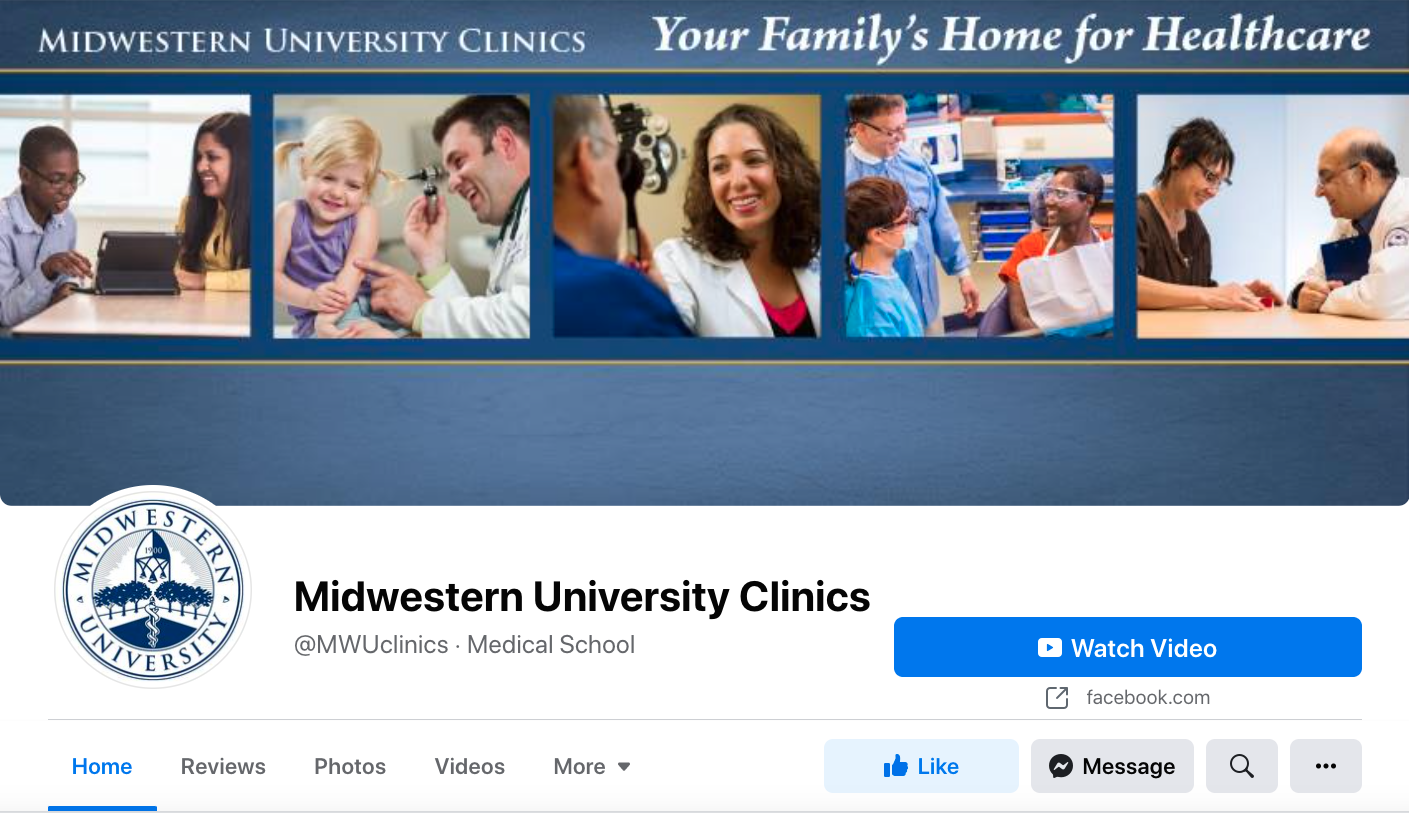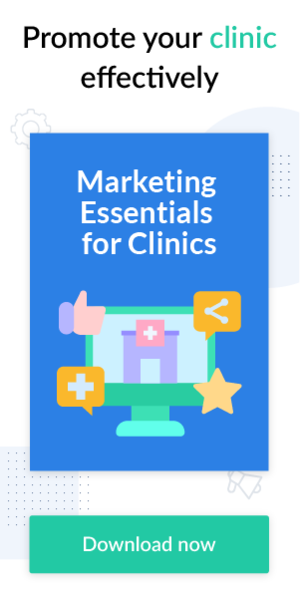Social media is one of the most effective ways to reach your target audience. Social media marketing allows you to build relationships and communicate with your prospective patients while helping them make informed healthcare decisions. But how should clinics use social media to promote their services? How can they keep their social media communication secure? You’ll find answers to these questions in this blog post.
Why social media matters to clinics
Before we dive into the benefits clinics can reap by implementing a social media marketing strategy, let’s take a look at some statistics.

Why this matters: Social media is a popular source of information. However, social networks are full of misleading information, which is rather frustrating when it comes to issues as sensitive as people’s health. Healthcare professionals can educate people by sharing helpful and valuable content and combating misinformation.

Why this matters: Positive feedback is a powerful tool for establishing patient trust. Reading other people’s reviews that prove the good quality of healthcare services creates a reputation that patients can trust.

Why this matters: Interacting with patients on social media allows healthcare professionals to get immediate responses from them and better understand their needs and requests. Moreover, clinic managers can evaluate their competitors’ social media marketing efforts to copy effective practices and avoid mistakes.
Key benefits of using social media marketing for medical practices
By using social media wisely, your clinic can:
- Become more trustworthy in the eyes of your target audience
- Demonstrate expertise and thought leadership
- Introduce your facility and staff before patients enter your clinic
- Showcase your staff’s achievements
- Reach more patients and encourage them to book appointments
- Share patient reviews and testimonials with prospects
- Enhance your brand’s reputation
- Increase patient engagement
- Demonstrate the patient experience you deliver
- Share news and updates about your clinic and services
- Network with colleagues working in other medical specialties
- Keep up with healthcare industry trends
With the above-mentioned statistics and benefits in mind, implementing a strong social media marketing strategy is no longer a matter of “if,” it’s a matter of “how.” Let’s see how you can use social media to market your healthcare facility.
Step #1 Choose the best hospital social media platform
Social media marketing for medical practice requires strategic thinking. First of all, you should understand what social media channel will work best for your facility. We recommend paying attention to two critical aspects: what network your target audience is likely to use and what platforms competing clinics use to promote their healthcare services.
Look at each social network’s peculiarities (gender ratio and largest age demographic) to see what social network best fits your goals.

There’s no point trying to maintain a presence on every social media platform. However, you can choose several for maximum impact, as each network offers different opportunities and is designed for different content formats.
Step #2 Create your profile
Once you’ve chosen a social media channel, you need to create your profile. On Facebook and LinkedIn, there are two options: you can create either a private page or a business page. The major difference is that a business page allows you to advertise your medical practice.
We recommend you create a business page for your facility. This will enable you to engage with your audience, share valuable content with them, and create targeted ads to attract new patients.
Step #3 Fill in your profile
This step is incredibly important, as information about your clinic is what users see first. Patients should understand what type of clinic you run, what services you offer, where you are located, etc.
Below, you’ll find some tried-and-true tips for creating the perfect social media profile no matter what channel you choose.
- Use your brand name as your business name on social media and use it across all platforms.
- Add your profile picture. It’s best to use your clinic’s logo.
- For networks like LinkedIn and Facebook, also add a cover photo that demonstrates your facility. It’s a good idea to put your slogan on the cover photo. Ensure the text is visible and that your profile picture doesn’t cover it.
- Facebook also allows you to add a cover video. It can be a mini ad of your clinic playing on a loop.

- Write a professional bio. Each social network has a different character limit for its bio section, so make sure to edit your bio for each network to share the most important things about your clinic in the space available.

Here is what the Mayo Clinic’s Twitter bio looks like.

- Ensure you use relevant keywords in your social media bio for prospects to be able to find your healthcare practice
- Leave links to your accounts on other social media networks and to your website.
- Leave a link for booking an appointment.

Some solutions like ExpertBox offer a booking page allowing your patients to self-book 24/7 without playing phone tag and needing to reach you within working hours. A booking page offers an easy way for your prospective patients to see your availability and book appointments with you in a click without leaving your social media profile. It can help you deliver an excellent patient experience.
Step #4 Share valuable content
First of all, the content you share should cover the needs of your target audience and, at the same time, work for positioning your brand and accomplishing your clinic’s business goals. Keep the number of publications that evoke negative emotions to a minimum. People don’t want to read about something scary in their news feed. Therefore, present content that is constructive and positive.
At the same time, useful content can and should be combined with entertaining content. Fun facts, motivational quotes, etc. are perfect for social media. We recommend a polite, kind-hearted, and at the same time professional tone of voice.
All content you create and share can be divided into three categories — image-building to show the advantages of your clinic and services and to showcase your expertise, informative to provide answers to patients’ questions, and educational to dispel fears and concerns and push for a decision.
Below, you can find an example of how one clinic categorized different types of content.
| Post type | Patients’ pains | Rubric |
|---|---|---|
| Image-building posts |
Why should I trust this clinic? Are the doctors experienced enough? Will I be satisfied with the outcome? |
Before/after results Patient stories Meet the staff Videos about the clinic Complicated cases Why us |
| Informative posts |
How to use the service What difficulties might I face? What should I expect after surgery? |
Patient journey Our services Life after surgery |
| Educational posts |
Do I know enough to make a decision? How surgery goes |
Myths Diagnoses Surgeries and manipulations |
When posting on social media, follow these tips:
- Choose relevant topics
- Write easy-to-understand posts
- Post regularly
- Combine various formats that are best for the chosen network
- Put your audience first
- Create content in your brand voice
- Use compelling headlines
- Write well-structured posts
- Add calls to action to engage with the audience
- Use branded hashtags
Learn how to promote your clinic efficiently with our marketing essentials guide with best patient acquisition strategies.
Step #5 Engage with your audience
Social media is all about engagement. Social media marketing for healthcare professionals offers a huge opportunity for your clinic to communicate with your target audience. Here are some ideas how it can be done:
-
Respond to questions, mentions, and messages. Address users by name and pay attention to what they’re saying. Even if you’ve written scripts to answer frequently asked questions, don’t copy them completely — a user should feel they’re talking to a real person, not a robot.
Questions asked publicly should be answered similarly — don’t take the conversation to private messages unless it’s necessary. First, other people can find helpful information in the conversation. Besides, you’ll show that you’re ready for dialogue.
-
Respond to negative comments and reviews. Negative comments and reviews are damaging to your clinic’s image, and by staying silent, you only aggravate the situation. While responding to negative comments or reviews, remember that you should be polite and calm and provide an answer as quickly as possible.
With the right reaction on your part, you can easily protect your reputation and even improve it.
- Hold Q&A sessions. Such sessions allow your clinic to have a conversation with your prospective and current patients to identify their needs. This is the key to improving the quality of your services and enhancing the patient journey.
- Conduct polls and surveys. Polls and surveys offer an opportunity for healthcare professionals to gather data you might not be able to glean from other communication channels.
Final thoughts
All of your actions to promote your medical center on social media should be based on a unified marketing strategy and on your goals and objectives. The greatest success awaits clinics that know their target audience well, create useful content, engage with their audience, and promptly respond to questions that arise.
Subscribe to learn more about effectively promoting your clinic.
FAQ
-
There are no rules that forbid doctors to add patients on social media, however, they are still advised against doing it, because social media platforms often contain personal information that might ruin professional relationships. Moreover, patients might want you to consult them on social media, which is impossible due to security issues of social media platforms.
-
Using social media marketing for clinics can be an effective way to reach and engage with your target audience, build brand awareness, and attract new patients. Here are some steps to help you leverage social media for clinic marketing:
- Define your goals
- Identify your target audience
- Choose the right social media platforms
- Create a content strategy
- Consistent branding
- Engage with your audience
- Use visual content
- Leverage user-generated content
- Utilize paid advertising
-
When developing a social media marketing strategy for hospitals, it's important to consider the specific goals and needs of your institution. Here are some key elements to include in your strategy:
- Establish your objectives
- Identify your target audience
- Choose the appropriate social media platforms
- Develop valuable content
- Showcase expertise and thought leadership
- Encourage patient engagement
- Highlight patient testimonials
- Leverage visual content
- Engage with the healthcare community
- Monitor and measure results




